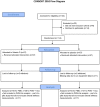A prospective randomized controlled trial of the effects of vitamin D supplementation on cardiovascular disease risk
- PMID: 22586483
- PMCID: PMC3346736
- DOI: 10.1371/journal.pone.0036617
A prospective randomized controlled trial of the effects of vitamin D supplementation on cardiovascular disease risk
Abstract
Vitamin D (VitD) supplementation has been advocated for cardiovascular risk reduction; however, supporting data are sparse. The objective of this study was to determine whether VitD supplementation reduces cardiovascular risk. Subjects in this prospective, randomized, double-blind, placebo-controlled trial of post-menopausal women with serum 25-hydroxyvitamin D concentrations >10 and <60 ng/mL were randomized to Vitamin D3 2500 IU or placebo, daily for 4 months. Primary endpoints were changes in brachial artery flow-mediated vasodilation (FMD), carotid-femoral pulse wave velocity (PWV), and aortic augmentation index (AIx). The 114 subjects were mean (standard deviation) 63.9 (3.0) years old with a 25-hydroxyvitamin D level of 31.3 (10.6) ng/mL. Low VitD (<30 ng/mL) was present in 47% and was associated with higher body-mass index, systolic blood pressure, glucose, CRP, and lower FMD (all p<0.05). After 4 months, 25-hydroxyvitamin D levels increased by 15.7 (9.3) ng/mL on vitamin D3 vs. -0.2 (6.1) ng/mL on placebo (p<0.001). There were no significant differences between groups in changes in FMD (0.3 [3.4] vs. 0.3 [2.6] %, p = 0.77), PWV (0.00 [1.06] vs. 0.05 [0.92] m/s, p = 0.65), AIx (2.7 [6.3] vs. 0.9 [5.6] %, p = 0.10), or CRP (0.3 [1.9] vs. 0.3 [4.2] mg/L, p = 0.97). Multivariable models showed no significant interactions between treatment group and low VitD status (<30 ng/mL) for changes in FMD (p = 0.65), PWV (p = 0.93), AIx (p = 0.97), or CRP (p = 0.26). In conclusion, VitD supplementation did not improve endothelial function, arterial stiffness, or inflammation. These observations do not support use of VitD supplementation to reduce cardiovascular disease risk.
Trial registration: ClinicalTrials.gov NCT00690417 NCT01049048.
Conflict of interest statement
Figures


References
-
- Holick MF. Vitamin D deficiency. N Engl J Med. 2007;357:266–281. - PubMed
-
- Looker AC, Dawson-Hughes B, Calvo MS, Gunter EW, Sahyoun NR. Serum 25-hydroxyvitamin D status of adolescents and adults in two seasonal subpopulations from NHANES III. Bone. 2002;30:771–777. - PubMed
-
- Autier P, Gandini S. Vitamin D supplementation and total mortality: a meta-analysis of randomized controlled trials. Arch Intern Med. 2007;167:1730–1737. - PubMed
-
- Lavie CJ, Lee JH, Milani RV. Vitamin D and cardiovascular disease will it live up to its hype? J Am Coll Cardiol. 2011;58:1547–1556. - PubMed
-
- Anderson JL, May HT, Horne BD, Bair TL, Hall NL, et al. Relation of vitamin D deficiency to cardiovascular risk factors, disease status, and incident events in a general healthcare population. Am J Cardiol. 2010;106:963–968. - PubMed
Publication types
MeSH terms
Substances
Associated data
Grants and funding
LinkOut - more resources
Full Text Sources
Medical
Research Materials
Miscellaneous

